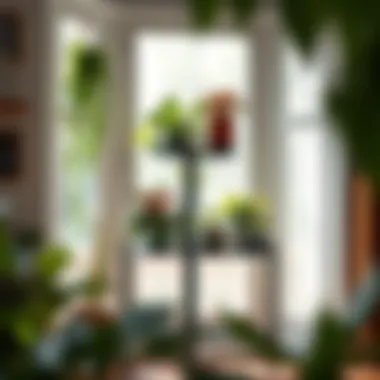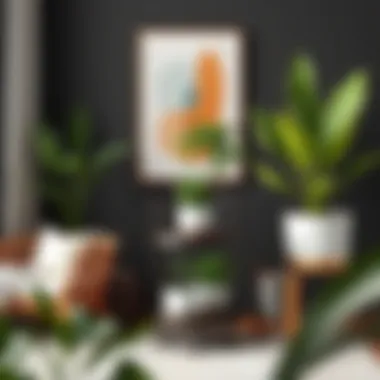Maximizing Space with Three-Tier Plant Stands


Intro
In today’s world, where urban landscapes can feel a tad cramped and nature is often pushed to the sidelines, the importance of incorporating greenery into our homes cannot be overstated. Three-tier plant stands emerge as a practical solution, enabling even the smallest of spaces to embrace the beauty of nature. These elegant structures not only serve as homes for your favorite plants but also enhance the aesthetic appeal of your living space. This article will provide a comprehensive guide to understanding the various elements that make three-tier plant stands versatile components of interior design.
Furniture Styles and Trends
Modern vs. Traditional: Understanding the Aesthetics
To truly appreciate the role of three-tier plant stands, one must first explore the contrasting aesthetics of modern and traditional designs. Modern plant stands, often characterized by clean lines and minimalist designs, seamlessly integrate into various spaces, from sleek apartments to contemporary offices. Materials like metal and glass are commonly used, lending a touch of sophistication to any environment. In contrast, traditional plant stands favor ornate details and rich, warm woods. They are ideal for spaces steeped in history and charm, creating an inviting atmosphere that beckons to those who appreciate the classics.
"Choosing the right plant stand style is like finding the perfect frame for a masterpiece; it enhances the overall appeal."
Color and Material Trends: What's In and What's Out
When selecting a three-tier plant stand, the color and materials can significantly influence the overall decor. Currently, earthy tones such as terracotta, muted greens, and warm neutrals dominate the trend. They evoke a sense of tranquility and blend well with natural elements found in plants. On the other hand, bold colors like royal blue or vibrant yellow may take the spotlight for those looking to make a statement.
Materials like bamboo, and reclaimed wood are popular choices as well, showing a commitment to sustainability. Conversely, plastic and overly processed materials are becoming a thing of the past, as consumers lean towards options that are both stylish and environmentally friendly.
Furniture Care and Maintenance
Tips for Prolonging the Life of Your Furniture
Three-tier plant stands, like any piece of furniture, require some attention to keep them looking their best. Here are a few tips:
- Regular Dusting: Use a soft cloth to wipe away dust, preventing any buildup that could damage the finish.
- Moisture Control: Ensure that the area around the stand is not overly humid, as this could lead to mold growth or deterioration of the material.
- Proper Placement: Avoid placing the plant stand in direct sunlight for extended periods, as this can cause fading or warping.
- Use Coasters: If your plants are in pots that can leak water, always place a coaster underneath to protect the stand from water damage.
DIY Repair Hacks for Common Furniture Issues
Every piece of furniture eventually faces wear and tear, and knowledge of simple DIY repairs can be a lifesaver. For three-tier plant stands, consider the following hacks:
- Fixing Scratches: A mixture of equal parts vinegar and olive oil can often replenish the finish on scratched wood surfaces.
- Stabilizing Wobbly Legs: If a stand feels unsteady, check for loose screws. Tightening these can restore balance. If the legs are uneven, adding small felt pads to the shorter leg can help as well.
- Covering Nicks: For minor dings, furniture markers match the wood finish and provide a quick visual fix.
Ending
Foreword to Three-Tier Plant Stands
The world of interior decoration is in a constant dance, combining aesthetics and functionality. One element that has captured the interest of homeowners and designers alike is the three-tier plant stand. This piece of furniture offers more than just a resting place for your plants; it elevates the entire ambiance of a room—literally and figuratively. With plants increasingly seen as essential to creating a vibrant home environment, understanding the nuances of these stands becomes crucial.
Definition and Purpose
Three-tier plant stands are multi-level surfaces designed specifically to accommodate a variety of plants. Unlike single-tier options that can limit the variety displayed, three-tier designs allow for an impressive collection of greenery.
These stands hold various sizes and types of pots, showcasing everything from cascading vines to potted succulents. Furthermore, the purpose extends beyond mere beauty. They optimize vertical space, making them ideal for apartments or homes with limited floor area. Whether sitting in a sun-drenched corner or strategically placed near a window, they help to create a miniature indoor garden that can improve air quality and boost one’s mood.
History and Evolution
The use of plant stands isn’t a recent trend. Historically, they have adorned homes for centuries. Early adopters can be traced back to intricate wooden creations of the Victorian era, which displayed exotic plants as status symbols. These stands not only showed off prized flora but also illustrated changes in interior design preferences over time.
With the mid-20th century came a shift towards modern design principles embracing minimalism and functionality. The advent of new materials, such as metal and plastic, gave rise to a whole new breed of plant stands. Today, they embody a fusion of styles—from rustic to industrial, appealing to a variety of tastes and design philosophies. They’ve evolved from a mere storage solution into focal points that can reflect individual style, whether through bold color choices or minimalist aesthetics.
Design Considerations
The design of three-tier plant stands is not just an aesthetic choice; it embodies a balance of functionality and style. When selecting a plant stand, it's vital to consider both the visual and practical elements that will influence your space. The right design can not only enhance the beauty of your plants but also optimize their growth environment.


Styles and Aesthetics
- Modern
Modern plant stands are often characterized by their clean lines and minimalist design. This style emphasizes simplicity, allowing your plants to take center stage while providing a sleek framework. Why are they popular? Because they seamlessly integrate into contemporary homes without overwhelming the space. A notable feature of modern designs is their use of geometric shapes, which can bring an urban feel to your room. They do have a downside: simplicity sometimes leads to a lack of character if not paired thoughtfully with decor. - Rustic
Rustic styles draw inspiration from nature and traditional craftsmanship. These stands often showcase natural wood grains and imperfections, giving each piece a unique touch. Homeowners are drawn to rustic designs because they evoke a sense of warmth and comfort. The unique feature here is the organic feel that blends well with a variety of plant types. However, rustic stands may require more maintenance to preserve their charm over time. - Industrial
Industrial plant stands incorporate raw materials like metal and reclaimed wood, echoing the aesthetic of factories and warehouses. This style shines in modern lofts or urban settings, as it infuses a bit of edgy flair into any room. A key characteristic is their durability; industrial stands are built to last and can support larger plants easily. But they might not suit a more delicate or traditional decor setup, as their bold appearance can dominate the visual space. - Minimalist
Minimalism is all about "less is more." It champions functionality and avoids unnecessary embellishments. Minimalist plant stands often come in monochrome tones without elaborate details. This style is appealing for its understated elegance, perfect for small spaces. The advantage of minimalism is that it encourages a clean environment, making plants look purposeful and chic. On the flip side, some may view this style as too sterile or lacking in personality.
Material Choices
- Wood
Wood offers warmth and character, making it a favored choice among plant stand materials. Often well-crafted, wooden stands can bring an earthy feel to your decor. A distinctive feature is the range of finishes available, from polished to weathered. They blend well with many architectural styles, enhancing the overall vibe of your home. The downside? Wood might warp or sustain damage if exposed to excess water, requiring diligent care. - Metal
Metal stands are robust and often present an industrial or modern vibe. Their strength allows them to support heavier plants while adding a sleek look to your aesthetic. Most designs are easy to clean and durable, standing firm against wear and tear. However, metal can get cold and unwelcoming, potentially clashing with softer decor elements, so pairing them thoughtfully with your overall theme is crucial. - Plastic
Plastic plant stands are incredibly versatile and often more affordable. They come in various colors and styles, allowing for customization to fit personal tastes. Their lightweight nature makes them easy to move around, a significant advantage for rearranging your space. But, they often lack the same longevity as other materials and may fade or crack over time if not treated with care. - Composite Materials
Composite materials combine the best features of plastic and wood, offering durability while maintaining a natural appearance. These stands can mimic wood's texture with the ease of maintenance typical of plastics. They are a beneficial choice for those seeking eco-friendly options without sacrificing style. However, depending on the quality, some composites might not hold up as well as solid wood or metal when it comes to heavier plants or larger installations.
In summary, choosing the right design and material for a three-tier plant stand requires careful consideration. By aligning your choice with your interior style and practical needs, you can create a harmonious living space that uplifts both your plants and your decor.
Functional Benefits
The topic of functional benefits plays a crucial role in understanding how three-tier plant stands can enhance various aspects of our living spaces. These stands are not just decorative items but serve multiple purposes that are often overlooked. They transform how we utilize space, improve plant health, and even contribute to our overall well-being.
Space Maximization
Three-tier plant stands are the unsung heroes of space optimization, especially in smaller homes or apartments where every square foot counts. When space is at a premium, it becomes essential to think horizontally and vertically. A three-tier plant stand allows homeowners to take advantage of vertical space, stacking plants in ways that a single-level pot wouldn't accommodate.
- Utilization of Vertical Space: With a three-tier design, you can easily display a variety of plants at different heights. This not only makes for an eye-catching display but also allows for better air circulation and sunlight exposure for each plant.
- Creating a Focal Point: A well-arranged trio of plants can draw the eye and create a standout feature in any room. This can make a space feel more open and inviting.
- Versatile Placement: These stands can fit snugly into corners or narrow spaces, turning what might be wasted room into a green oasis. Whether you slide one against a wall in your living area or place it as a divider between spaces, the potential for maximizing your environment is significant.
In essence, a three-tier plant stand doesn’t merely hold plants; it plays a dynamic role in how we perceive and use our space.
Improved Plant Care
Plant care can easily become a burden for many, but a well-designed three-tier stand can lighten that load. By organizing plants based on their specific needs, these stands make it easier to keep everything thriving.
- Easy Accessibility: Having multiple tiers means that each plant can be at eye level—no more bending down or stretching awkwardly to reach them. This accessibility contributes to regular maintenance, like watering and pruning, which helps ensure plants stay healthy.
- Separation of Plant Varieties: Different plants often have varying light and watering requirements. A three-tier plant stand allows you to group plants with similar care needs, facilitating a more tailored approach. By placing plants requiring more light on the highest tier and shade-loving varieties below, you'll promote healthier growth.
- Airflow and Light Distribution: With careful arrangement, the open design of these stands allows for better airflow and natural light exposure. This is particularly beneficial in preventing common problems like mold or pests that thrive in low light or humidity.
A well-designed plant stand can transform your plant care routine from a chore into an enjoyable activity, where everything you care for is within arm's reach.
In summary, the functional benefits of three-tier plant stands extend far beyond mere aesthetics. They enhance space usage, encourage better plant care, and add a touch of greenery that complements any home style. By understanding and leveraging these benefits, homeowners, designers, and DIY enthusiasts alike can dramatically elevate their living environments.
Selecting the Right Plant Stand
Choosing the right plant stand is a crucial step that sets the stage for how your greenery is displayed and cared for. Whether you're an interior designer with an eye for aesthetics or a homeowner just dipping your toes into the plant world, the right plant stand can create visual harmony and maximize your space. With the versatility of three-tier plant stands, selecting the proper one can enhance your living environment while ensuring your plants thrive.
Assessing Available Space
Before even thinking about style or materials, assessing the space available in your home is fundamental. Where are you planning to place your plant stand? Is it in a cozy corner of your living room or on a balcony that catches the morning sun? Here are a few things to weigh in on:
- Measurements: Take measurements of the area where you plan to place the stand. This will guide you in choosing a stand that fits comfortably without overwhelming the space.
- Flow of Movement: Consider the traffic flow in common areas. A stand fitted tightly against a wall might be perfect for narrow spaces, while freestanding designs can work wonders in more open areas.
- Light Conditions: Different plants thrive in different light conditions. Ensure the stand is positioned where it can receive adequate sunlight, but also monitor for any obstructions.
"A perfectly placed plant stand not only showcases your green friends but also harmonizes with your living space's overall vibe."
Recognizing the contours and limitations of your space will lead to a better selection that enhances your home instead of cluttering it.
Choosing Height and Width
Once you've scoped out your space, the next consideration is the height and width of the plant stand. The dimensions you choose can have a significant impact on both aesthetics and functionality. Here’s what to look for:
- Height Considerations: Are you using the stand to showcase tall, dramatic plants or smaller additions? A taller stand can elevate the view of your plants and allow for a cascading effect with trailing plants on the top tier. Consider easiy access for watering too; you don’t want to wrestle with a sprayer or get creative with your yoga moves to reach the top plants.
- Width Matters: This isn't just about fitting into spaces. The wider the stand, the more plants it can hold. However, too much width can overpower a small nook. Ideally, the plant stand should feel in balance with other furniture, creating unity rather than dissonance.
- Adjustable Features: Some options come with adjustable height features, giving you flexibility as your plant collection changes. This can save you from having to buy multiple stands as your plant family grows.
In summary, selecting the right dimensions of a three-tier plant stand takes careful thought, but when done right, it can significantly enhance not just the plant's health but also your overall living area.


Styling Your Plant Stand
When it comes to interior design, styling a plant stand is not just a matter of aesthetics; it’s an art that combines functionality and beauty. A well-styled plant stand can serve as a focal point in a room, drawing the eye and adding a touch of nature to a variety of settings. Understanding how to properly style your plant stand is crucial because it allows homeowners to enhance their living space, create atmospheres that resonate with their personality, and even improve the overall health of the plants housed within them.
Placement in Interior Design
Living Areas
Living areas are often the heart of the home. This is where families gather and entertain, making it a prime spot for a three-tier plant stand. A key characteristic of living areas is their versatility. They can be styled to reflect both comfort and elegance. By integrating a plant stand into this space, you introduce greenery that can significantly boost ambiance and air quality.
A unique feature of placing a plant stand in a living area is the opportunity to create height and depth in your decor. Consider grouping taller plants on the top tier to draw the eye upward. Not only does this add visual interest, but it can also make smaller spaces appear roomier.
However, one must also consider the disadvantages. A large, bulky plant stand can potentially overcrowd a small living room space, making it cumbersome. Therefore, the right size and style must be chosen to avoid overwhelming this important area of the home.
Balconies
Balconies provide an excellent outdoor extension of the living space, allowing for fresh air and sunlight. They often have a key characteristic of compactness, which is beneficial for urban dwellers. A three-tier plant stand can turn a small balcony into a lush retreat, maximizing the limited area effectively. You can adorn each tier with different plant types, from trailing vines to sturdy succulents, creating a mini-garden that delights the senses.
One unique feature of using plant stands in balconies is the way they can complement outdoor furniture. This synergy creates a cozy atmosphere perfect for relaxation or social gatherings. That said, balconies also have their drawbacks. They are exposed to weather conditions that might impact the plant's health, necessitating a bit more care and consideration in terms of material choice and plant selection.
Offices
The modern office environment is increasingly tending toward biophilic design, which incorporates nature into workspaces. Here, a three-tier plant stand can contribute significantly to this goal. A key characteristic of offices is their often sterile appearance, typically dominated by metal and glass. Introducing greenery through a plant stand can soften this look, creating a more inviting atmosphere that enhances employee wellbeing.
In offices, plant stands also offer the unique advantage of versatility. Depending on their design, they can fit into almost any corner or niche, maximizing limited space. However, one must note that not all plants thrive indoors with artificial light, so it is essential to choose low-light varieties to maintain productivity without compromising plant health.
Combining with Other Decor
Combining your plant stand with other decor elements can further enhance the visual appeal of your space. Grouping plant stands with art pieces, photographs, or even books can create a coherent theme that tells a story about your lifestyle and interests. Avoid choosing decor that competes with the plant stand; instead, let it compliment the greenery. For instance, using neutral tones or natural textures around the stand can emphasize the vibrancy of your plants. Whether you opt for a minimalist approach or something more eclectic, successfully combining decor with your plant stand can effectively create a harmonious and inviting living environment.
Maintenance and Care
Taking care of your three-tier plant stand is more than just a suggestion; it's an essential part of ensuring your plants flourish and your decorative piece remains visually appealing. Proper maintenance not only prolongs the lifespan of the stand itself but also enhances the health of the plants it holds. These stands, with their multiple tiers, often collect dust and grime, which can obstruct growth and reduce the overall aesthetic appeal. Therefore, paying attention to cleaning routines and seasonal adjustments can elevate both appearance and function.
Cleaning and Upkeep
Cleaning your three-tier plant stand should be a regular ritual akin to watering your plants. Dust accumulation can hinder light absorption, especially for plants that thrive on the top tier. Here are some tips for cleaning:
- Dust Regularly: Use a soft cloth or microfiber cloth to wipe down the surfaces of the stand each week. This practice prevents dust from settling and makes deeper cleaning easier.
- Deep Cleaning: Every month or so, remove the plants and give the stand a thorough wash. If it's wooden, a damp cloth suffices; for metal stands, you might consider a gentle soap solution.
- Plant Pot Maintenance: Clean the pots themselves too, as dirt and algae can build up. An occasional rinse with water can keep them looking sharp.
- Inspect for Damage: During cleaning, take the time to check the stand for any signs of wear, like rust or loose joints. Addressing these issues promptly can avoid bigger repairs later.
Maintaining your plant stand regularly not only keeps it looking spick and span but also helps in nurturing a healthy plant environment.
Seasonal Adjustments
As seasons change, so do the light and temperature conditions in your home. This is where seasonal adjustments come into play.
- Light Exposure: Rotate the plant stand based on how sunlight enters your home during different times of the year. In the summer, you might want to move it closer to windows for optimal sunlight, while in winter, a slight shift might be necessary to shield your plants from too much cold.
- Temperature Management: In colder months, ensure your plants aren't in direct drafts from windows or heating elements. This means sometimes moving your stand to a more sheltered location.
- Watering Schedule: Seasonal changes in temperature and light conditions may also require a rethink of your watering routine. Plants may need less water in the cooler months, so adjust accordingly.
- Refresh Soil: At the start of spring, refreshing the soil in your pots can prepare your plants for growth. This preventative measure works wonders in keeping your stand and plants healthy through the season.
For more information on proper plant care, you can check out The Spruce and explore their extensive range of gardening resources.
Budget Considerations


When embarking on the journey to select the ideal three-tier plant stand, financial aspects play a crucial role. This section aims to demystify the budgeting process, revealing how it influences choice and enhances the overall experience of creating a lush indoor garden. Achieving a balance between aesthetic appeal and economic feasibility is paramount, especially for homeowners, designers, and DIY enthusiasts keen on incorporating greenery without breaking the bank.
Price Range Overview
Three-tier plant stands span a wide spectrum of prices. This variability reflects not only the materials used but also the craftsmanship involved. Here’s a clearer picture of what to expect:
- Budget-friendly options: These can range from $30 to $80, often made of plastics or lower-grade woods. They might lack intricate designs but still serve their purpose effectively.
- Mid-range choices: Priced between $80 to $200, these stands typically feature better quality materials like solid woods or treated metals. Aimed at both aesthetic appeal and durability, they are designed to last longer while blending well with various decor styles.
- High-end varieties: For those whose pockets are deeper, stands can go upwards of $200. They often showcase exclusive craftsmanship, unique styles, and premium materials, making them ideal for accentuating sophisticated spaces.
It's essential to keep in mind that investing more doesn't always guarantee greater satisfaction. Factors such as personal taste, home decor, and the intended use of the stand should guide decisions.
Cost-Effective Options
For those on a budget, achieving the dream setup doesn’t mean settling for less. Here are some savvy strategies to keep costs low while still creating a stunning display:
- DIY Plant Stands: Crafting a three-tier stand from reclaimed wood or old furniture can yield a unique piece tailored to one’s taste. This approach isn’t just budget-friendly but often results in a more personalized touch.
- Thrift and Second-Hand Finds: Exploring thrift stores or online marketplaces like Facebook Marketplace can uncover hidden treasures. A bit of refurbishment can transform a weathered stand into a chic focal point in any room.
- Seasonal Sales and Discounts: Keeping an eye on seasonal promotions or retailer clearance events can lead to significant savings. Many stores offer discounts around holidays, providing a golden opportunity to score quality stands at reduced prices.
Proper budgeting, combined with thoughtful planning, ensures that the addition of a three-tier plant stand enhances your living space beautifully, without leading to unnecessary financial strain.
"Quality in a product or service means making it fit for its intended purpose." – Peter Drucker
By weighing options carefully and considering all possibilities, one can enjoy the benefits of a sophisticated and functional plant stand that complements the aesthetic of their home.
Sustainability in Plant Stand Design
Sustainability is more than just a buzzword; it's a way of living that impacts our environment positively. When it comes to three-tier plant stands, choosing sustainable design not only meets aesthetic desires but also aligns with a growing ethos of ecological responsibility. As homeowners and designers, embracing sustainability means making choices that respect and protect our planet for future generations. This section will explore how sustainable practices can enhance your selection of plant stands, showcasing eco-friendly materials and supporting local artisans.
Eco-Friendly Materials
Selecting materials for three-tier plant stands is crucial. Traditional materials like plastic and certain metals contribute to environmental degradation. In contrast, eco-friendly materials provide a more responsible alternative. Here are some notable options:
- Bamboo: Fast-growing and immensely strong, bamboo is a grass that can be harvested sustainably. It’s naturally resistant to pests and doesn’t require pesticides, making it an excellent choice for environmentally conscious consumers.
- Reclaimed Wood: This type of wood has a rich history and character, making every piece unique. By using reclaimed wood, you're giving new life to materials that might otherwise end up in a landfill, reducing waste significantly.
- Recycled Plastic: Some manufacturers are now creating plant stands from recycled plastics. This not only helps keep plastic out of landfills but also promotes a circular economy.
"Choosing eco-friendly materials is not only a statement but a commitment to the planet. Every small step can lead to significant changes in our environment."
Supporting Local Artisans
When you opt for plant stands made by local craftsmen, you're not just purchasing a product but also investing in your community. Here’s why supporting local artisans is an important aspect of sustainable plant stand design:
- Economic Impact: Buying locally helps stimulate your local economy. When artisans craft products, they often use locally sourced materials, reducing transportation emissions.
- Cultural Preservation: Local artisans often incorporate traditional techniques and designs that reflect your area’s unique culture. This helps keep those traditions alive while providing distinctive pieces that mass-produced items cannot offer.
- Quality Assurance: Typically, local artisans take great pride in their work, leading to higher quality products that last longer. Durable stands mean fewer replacements and less waste over time.
Culmination
The importance of this conclusion lies not just in summarizing the preceding content, but also in framing the broader relevance of three-tier plant stands in modern living spaces. By reinforcing the key takeaways, readers can better appreciate how these stands serve as effective tools for both practical plant care and aesthetic enhancement. This dual functionality is essential for making informed decisions when choosing the right stand for their needs.
Recap of Benefits
To revisit the various advantages discussed, three-tier plant stands provide a multifaceted solution for plant enthusiasts and homeowners alike.
- Space Efficiency: They utilize vertical space, ideal for apartments and smaller homes.
- Versatile Styling Options: They come in various designs, from minimalist to rustic, complementing different interior styles.
- Improved Plant Health: Organizing plants in tiers allows for better light distribution and air circulation.
- Easy Maintenance: With accessible arrangements, routine care becomes simpler.
Thus, investing in three-tier plant stands not only maximizes utility but also brings a breath of fresh air to interior decor, enhancing overall living quality.
Final Thoughts on Plant Stands
Reflecting on the role three-tier plant stands play in home environments, it's clear that their value extends far beyond mere functionality. They become a canvas for expressing personal style and integrating nature into indoor spaces. Each stand tells a unique story, whether showcasing a collection of succulents, air plants, or cascading vines.
"Three-tier plant stands represent a harmonious blend of form and function, making plant care aesthetically pleasing and practical."
Moreover, as the trend towards sustainability grows, these stands allow individuals to support local artisans or choose eco-friendly materials, contributing to a broader movement towards conscious consumerism. By adopting such versatile plant stands, homeowners not only cultivate greenery but also curate a living space that reflects their values and tastes, ultimately enriching their day-to-day lives.















